Chris Baty's Blog, page 49
October 26, 2020
Getting Prepared for NaNoWriMo! (With BookTuber FictionalFates and Scrivener)

Every year, we’re lucky to have great sponsors for our nonprofit events. Scrivener, a 2020 NaNo sponsor, is an award-winning writing app that has been enthusiastically adopted by best-selling novelists and novices alike. Today, they’ve partnered with BookTuber Joel Rochester, a.k.a. FictionalFates, to help you get prepared for the month ahead:
At thirteen years old, I participated in NaNoWriMo for the first time. At that point in my life, being challenged to write 50,000 words in thirty days was daunting and very scary. However, I persevered and I somehow managed to do it, albeit the novel I wrote that year will never see the light of day.
However, now at twenty years old, I’ve learned that NaNoWriMo is a great time to break the spine on a new tale, or one that I’ve been working on for years. (Rebels, I see you.) I guess you could refer to me as a “NaNo-Veteran”; someone who’s participated in NaNoWriMo for many years now. Scrivener has very kindly asked me to impart some wisdom on my experiences, whether you’re participating for the first time or looking to refresh that writer’s memory.
But first, have you announced your project yet? This November, I’ll be writing The Dream Prince, which is an enemies-to-lovers fantasy following two princes, one alive and one cursed to die, who converse through their dreams. They are forced to work together to break the curse, or both war and the plans of an ancient cult will come to fruition.
Now that’s out of the way, let’s get to how YOU, beginner or fellow veteran, can better your NaNoWriMo experience, with the help of Scrivener! I have used Scrivener for seven years now, and I don’t think I would’ve been as organized with my writing if it wasn’t for them.
NaNoPrepUsually, everyone takes the month of October to figure out and plan out their projects to write in November. However, we’re not always as organized as we’d like to be, scrambling at the last minute to come up with an idea. Don’t get discouraged — planner, pantser or plantser, there’s definitely ways for you to prep in your own way, and it’s on a sliding scale.
In my experience:
Pantsers (people who write off the seat of their pants) just need to know what direction their novel is going in, and perhaps some minor details about their characters and world. Planners (people who extensively plan their novel) plan enough that you know the general beginning, middle and end of your novel and that they know their characters to some extent. However, as with most plans, they might be thrown out the window throughout the month as they begin to realize more details about their novel. Plantsers (a combination of both, this is me!) plan until they’re comfortable, and then discover the rest. In my experience, I mostly have the beginning and end planned, and tiny bits of the middle, and then the rest is to be found during the month!Scrivener makes it super easy for beginners to prep their novels. By using their corkboard view, you can plot cards and rearrange as you wish. Plus, they have templates for character and setting profiles too, making it easier for you to flesh out your characters as you wish. And with the index on the left, you can arrange them into folders, making everything very neat and organized!
NaNoWriMoNovember will come and go as swiftly as this year has gone. Whilst on average, it’s roughly 1,667 words per day in order to write 50,000 words a month — our schedules don’t always accommodate that. So I would say to pace yourself according to your schedule throughout the month.
Have a free day? Try to get as much writing done during that day as it’ll make other days much easier to reach your goals.
Need to be productive? Check Twitter or the NaNo Forums, there will probably be someone hosting writing sprints, where you can write for short periods of time in order to contribute to your larger goal.
I’ve found that in the past, spending five 10-minute sessions throughout the day writing 100 words was much more productive than one 50-minute session trying to write 500 words. Small amounts of progress add to a larger feeling of completion.
This is also what makes Scrivener exciting as I’m able to set word count goals and see the progression bar fill up as I write. Just seeing that visual confirmation really keeps me motivated to keep going throughout the month.
Plus, with Scrivener I’m easily able to organize and write my novel on a scene-by-scene level — plus, I won’t have to copy and paste everything into a manuscript as Scrivener’s compile feature does that for me without the hassle!
Have Fun!Lastly, NaNoWriMo is a lighthearted fun challenge which most of all, encourages writers to write and make progress in their novels. Whilst winning and achieving the 50,000 word count goal is amazing, if you don’t win, the progress you made in November is still something to be proud of.
It’s important during this month to strive for progress rather than perfection. The words that you write during the month of November will only be the first of many drafts, so ensuring the words are down first of all is an essential step.
Have fun with your characters, have fun with your fellow writers. Maybe look to pick up the Traveling Shovel and use it in one of your scenes. This is a time to celebrate the fact that you have chosen to give life to an amazing story, so write it.
Overall, NaNoWriMo is such a fun month to get to know other writers, hone your craft and begin the progress of a novel you want to write. I hope that all of you make amazing progress over the course of November. Who knows, I might see you in some writing sprints!
For now, if you wanted to try out Scrivener, you can try out a free trial for 30 days and revel in the awesomeness. I highly recommend it, especially for those who are getting started with writing novels. Plus, if you use the code NaNoWriMo, you can get 20% off!
Good luck friends, and happy writing!
Joel Rochester is a writer of Welsh and Jamaican descent. As a young child, he saw books as an escape from the real world but he often found those books never truly represented him. He loves to read and write books about emotional boys, daring worlds, and intriguing tales. He advocates for more diversity in media. Particularly, more QPOC representation.
Presently, he reviews and discusses books through his popular social media presence, ‘FictionalFates’. He is also currently studying a BA (Hons) Creative Writing and English Literature at the University of Winchester.
When not writing or reading, Joel can be found consuming other media. Whether it be video games, Korean dramas, or browsing social media. He also never goes long without a mug of matcha tea by his side.
October 23, 2020
5 Lessons I Learned Writing a Book in a Pandemic
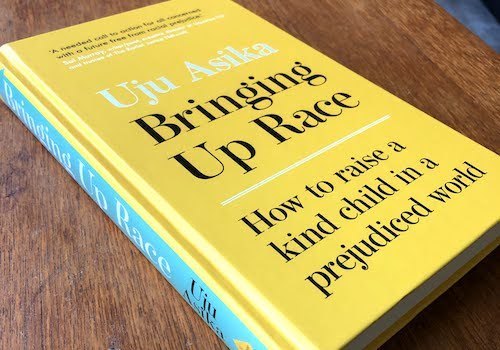
This year has presented us all with unexpected obstacles and challenges—not the least of which is a global pandemic. Today, author Uju Asika talks about what she learned in the process of writing and publishing a book this year:
As the author of Bringing Up Race: How to Raise a Kind Child in a Prejudiced World, which was published in September, one question people ask me is, “How on earth did you manage to write a book in a pandemic?”
I submitted the first draft of the manuscript 12 days before the UK went into lockdown, but I still had weeks of drafting, cutting and revising left to do.
Being a NaNoWriMo winner in 2018 (whoop whoop!), I was used to churning out words at speed. But this was a work of nonfiction involving interviews, studies and checking sources. Also the topic was both deeply personal and hugely important. I couldn’t just wing it. Here are 5 lessons I learned in the process of writing a book during a pandemic:
Lesson 1: It’s Ok to Freak OutI spent the first weeks of the pandemic scrolling news feeds 24-7 and becoming an amateur epidemiologist via the School of Google. Similarly, when I started writing the book, I lost entire days to ‘research’ (aka Facebook). I felt like a fraud, a sham, a big fat failure. Who told me I could write an entire book? Why did I think this was a good idea? Now I realize this was all completely normal. Freaking out is part of the process. Whether you are taking on a huge, scary project or a global outbreak, you are entitled to lose your shit at least for a bit.
Lesson 2: Take Regular BreaksAs a writer, once you’re disciplined enough to keep ‘butt in chair’, you might find yourself suffering sciatica, eye strain and other ailments. Likewise, if you don’t switch off from Trump tweets and Boris briefings, it can mess with your mind. Taking breaks is essential, both for your sanity and to replenish your creative well. You don’t have to go on a marathon hike or visit a remote island. Try a stroll around your neighborhood or an evening with Netflix instead of your laptop. (Just don’t use Netflix as an excuse to stop writing.)
Lesson 3: Pace YourselfAt the start of the pandemic, several world leaders claimed it would be over soon. However, common sense, instinct, and science says we are in it for the long haul. So don’t burn through those store cupboard recipes and homeschooling hacks. Equally, don’t try to write a book in one stretch (although you can do it in a month if you’re crazy enough). Set smaller goals like a daily word count or a timed writing session. Writing apps like Scrivener are great for helping you stay on track.
Lesson 4: The Only Way Out is ThroughThis sounds like the theme song from a disaster movie (apt for 2020) but it’s true. Whether tackling a creative venture or a crisis, the only way out is through. There are times you’ll want to turn back or give up entirely. But the best option is to keep moving forward until you see that glimmer of light at the other end. I used to fantasize about holding the finished book in my hand. But the only way to get there was to stop fantasizing and get to work. Or to paraphrase Finding Dory, just keep that ink swimming.
Lesson 5: The Magic is in the EditAsk any author, most of us would rather extract teeth than remove precious words from our manuscripts. However, something magical happens in the edit. Ideas that began as loose threads weave into shape. Your work is better for what you choose to keep and what you’re willing to let go. Some call 2020 a giant reset. I think it’s a giant edit. We are letting go of what no longer serves us. Discovering what truly matters and cutting out the other crap. It is painful on many fronts but I do believe we will emerge stronger, tighter and clearer for it.
I hope these lessons are useful to anyone attempting to write through difficult times. It’s ok to freak out, whether on the page or in real life. Take regular breaks both from writing and from world news. Pace yourself but keep moving forward because the only way out is putting one foot (or word) after another. And don’t worry if your project/home/life in general feels ridiculously messy right now. The magic is in the edit.

Uju Asika is a multiple award-nominated blogger, screenwriter and digital consultant. She is the author of Bringing Up Race: How to Raise a Kind Child in a Prejudiced World, published in September 2020 by Yellow Kite (Hachette). Buy the book on Amazon UK, Waterstones, Word on the Water (delivery to North America and Europe) and other good bookshops.
Author photo by Storm Davison.
October 22, 2020
3 Things Authors Should Know About Publishing

Every year, we’re lucky to have great sponsors for our nonprofit events. IngramSpark, a 2020 NaNo sponsor, is a self-publishing platform that can help you publish your novel in both print and e-book format. Today, they’re here to share a few things every author should know about publishing:
Taking the leap from writer to published author is a huge accomplishment—and often the end goal for writers who complete NaNoWriMo. We all write for different reasons. We’re motivated by different life experiences, and we pursue a wide variety of genres and plotlines, but once the writing is finished, we generally all want the same thing: to share our work with others. So if you’re considering publication for your writing, here are a few things to keep in mind.
Gone are the days when traditional publishing was the only way that “real” authors could publish their work. With advancements in technology, independent publishing has become an increasingly viable option. With the right printing and distribution, your book can look the same as any produced by traditional publishers—with the same availability. Not to mention, you can skip the gatekeepers, maintain creative control, and receive higher earnings per book sale.
Keep in mind that independent publishing will require you to seek help from a professional editor, book designer, and be willing to dive into your own book marketing, but all of these are easily accessible to indie authors and well worth the return on investment when you publish professionally.
2. Never Limit Your Book’s Potential ReachIf a reader wants to read your book, your book should be available to them—it’s as simple as that. You don’t know how readers will want to consume your content, so be sure it’s offered in print and ebook formats. Why exclude those who ONLY read print books or ONLY read ebooks?
Your reader may shop exclusively at their local independent bookstore, they may only shop for books online, or they might even leave their book discovery to libraries. Make sure your distribution doesn’t exclude any of these outlets. You never know who will want to buy your book; it may even end up being highly popular to those in a country other than your own. Make sure when you publish your book, your potential reach isn’t limited, globally or by distribution channel, so as not to exclude any potential readers from buying your book.
3. Education is KeyThe most successful authors and publishers are the ones who understand the publishing process, the publishing industry, and their audience. If any of these pieces are missing, your book can’t reach its full potential. If you’ve created a work that matters to you and you genuinely want to share it, you owe it to yourself and your book not to slack in these essential areas. Do your research to understand:
what kind of editing or design your book may needthe appropriate timeline for production and promotionwhat booksellers and libraries need from you and your book in order to carry itwhat kind of media coverage you can getwhat month is best to publish a book like yourswhat books similar to yours look likehow much they sell forand what keywords you may want to sprinkle into your book description to attract your target readers.All of these pieces are important to producing the best book you can, and all the information is available to you.
The only thing that stands between you and the publication of your book is a way to publish professionally, a way to ensure your book is shared widely, and the willingness to learn how to make your book a success (ideally, all within a reasonable price range to make sure your efforts pay off).
These things seem like a much lower barrier to entry than what is offered by the traditional publishing process, considering how much time and effort you dedicate to convincing others your book is worthy before ever seeing a dime. Independent publishing isn’t for everyone, but neither is traditional publishing, so it’s always good to be aware of your options and fully explore what’s right for you and your book.
All WriMos receive FREE title setup on print or ebooks (and free revisions) with IngramSpark until March 31, 2021, with promo code NANO.
Write with NaNoWriMo, publish with IngramSpark.If you’d like to learn more about how IngramSpark supports you produce quality publications, achieve global distribution, and access free resources to help you publish successfully, please visit the IngramSpark website.
Regardless of how you decide to pursue your publication goals, may your writing accomplishments be validated and your words well-read!
IngramSpark® is an award-winning independent publishing platform, offering indie authors and publishers the ability to create professional print books and ebooks. Self-publish a book and make it available to 40,000+ retailers and libraries—in stores and online—through IngramSpark’s global distribution network. To learn more about how you can share your story with the world, visit www.ingramspark.com.
Top photo by Ondrej Bocek on Unsplash.
October 21, 2020
Ask Yourself, Who Is Your Character?

What is the key to writing unique characters that are dynamic? How do you prevent writing token characters in the name of diversity? NaNo Participant Bee Rollason shares three amazing points to help you out this November.
The thing with “writing diverse characters” is that, when one puts it like that, it almost reads like an equation.
Writing + Diversity = Character
Unfortunately, it isn’t quite that easy. While we humans are all different - unique, as my grade-school teacher would put it — diversity is something else. It cannot be quantified, nor is there any sort of equation to show what it might actually look like. Diversity is, at its most fundamental, differences. A whole heaping pile of them – one “difference” does not usually suffice.
You may ask “why is diversity in characters important?”. From a reading standpoint, they can make your world more believable, interesting, and varied. The thing with being different is that, statistically speaking, people are more likely to be some combination of queer, disabled, or marginalized, than they are to be straight, white, able-bodied, and male – the “norm” most frequently seen in media, but less frequently seen everywhere else. From a human standpoint, having to put ourselves in the shoes of people who are different than ourselves is invaluable and educational, teaching us empathy of others – and other perspectives – that perhaps we hadn’t ever had to face before. Not only that, but it is empowering and affirming for those in marginalized or often-overlooked groups; an acknowledgement of “we see you; you do exist; we do care.”
So how does one write characters who are different than yourself? How does one even choose what type of diversity to add?
1. Ask (Different) QuestionsInstead of asking the questions above, ask your characters who they are. What if your character were gender-nonconforming, or gay? If they were Black or Latinx, or Jewish or Muslim? What if they require a wheelchair, or hearing aids (or perhaps they’re Deaf and use sign language)? There are so many options from which to choose!
2. ResearchTalk to people who are from the communities you want to write about, trawl through subreddits where people discuss their successes and experiences, and remember that people who get labeled as “diverse” are still just that: people. They have strengths and weaknesses, likes and dislikes, hopes and dreams. They also have identities that go beyond just “diverse”. Their diversity, their differences, form part of them; it is not the piece that determines their entire identity. It may shape them; it may even change things that we may not expect. But their diversity is not them.
3. Be GenuineNo one ever expects perfection at first, and if you are an author who has not ever really thought about diversity, or how to show it, then it will be no surprise if it is difficult. It is by being genuine that we share genuine stories; that we develop genuine characters whom our readers can connect with and believe in. In the research process, be sure to also look up how to discuss diversity in sensitive and respectful ways: what terms are okay to use, and when and how, and what are not. Authenticity must always be respectful.
There will be some who say “you can’t write that”. After all, some of the most oft-cited advice is “write what you know”. Be sure, though, to understand what type of story or character you are writing; there is a difference between including diverse stories, and writing a story about being diverse – especially in ways that you are not. Anyone can tell stories that include diverse characters. Stories about being diverse should always be left to those to whom it applies. Simply put, that’s not your story to tell.
However, if you are writing the former and taking that authentic approach to your characters, and you are doing the research to ensure that your portrayal of a diverse character is fair and representative (as opposed to stereotypical or even harmful), then there is no reason why you shouldn’t be able to include them. None at all. Your portrayal may not be perfect, but sometimes (frequently) the point is not perfection. The point is to learn, and grow, and try, and to use allyship to help amplify these people’s experiences. The inclusion of characters who are considered “diverse” normalizes it, and it becomes less unusual to see them. Positive representation of this diversity, too, can be and is an inspiration for people who see themselves in these characters.
Instead of the stagnant narrative of “straight white man saves the day”, we get heroes who are different. Heroes who may not be the ‘typical’, or the ones we expect. And those heroes are beautiful, every single one. Wanna know how I know?
I know because those heroes are us. We are absolutely stunning.

Bee Rollason is an experienced NaNoer, having participated for almost a decade (though not always winning) since high school. After stumbling into a Linguistics degree and learning Mandarin Chinese, they travelled to England for a spell before returning home to Australia. Being a queer young adult, they find a lot more joy in reading stories that have characters who are queer, as opposed to reading queer stories.
October 20, 2020
Pro Tips from a NaNo Coach: Organize for Novel-Writing Success
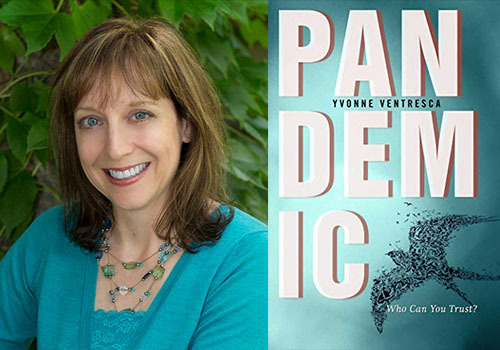
NaNoWriMo can seem like a daunting task sometimes, for NaNo newbies and veterans alike. Fortunately, our NaNo Coaches are here to help guide you through November! Today, author Yvonne Ventresca is here to share her advice on how to set yourself up for noveling success:
Congratulations on your commitment to write a novel! As your word count grows, it can be difficult to keep track of your novel’s details. Here are five organizational tips to help:
1. Keep track of your novel’s timeline.Print out a blank calendar for the time period when your story takes place. I use this free site to choose the months and years I need. Then mark fictional and real-world events on the calendar. This helps for planning how your story unfolds around weekends and holidays.
2. Keep a decision notebook.A decision notebook is a place where you can jot down your main premise, character ideas, names, jobs, etc. Here are some of my notes when I was brainstorming for my YA novel, Pandemic, on paper that I pasted inside. You can see the cross-out where I changed the main character’s name from Livvy to Lily, for example.
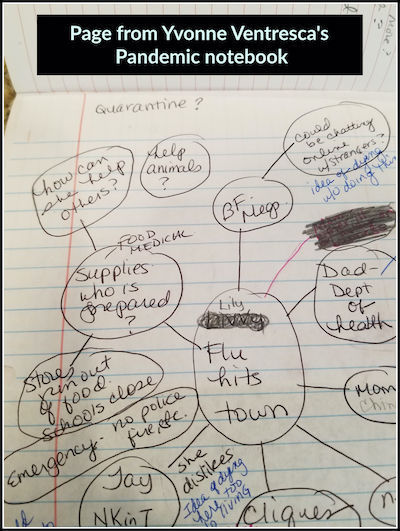
My notebook also contains scene drafts, character descriptions, and timelines that helped me keep of track how the story progressed chapter by chapter. This concept allows you to keep your key decisions in one physical place. It’s also a good spot to save questions that still need further research, and even people you want to thank in future acknowledgments.
3. Create an idea board.
If you use Pinterest, create a new board to save novel-related pictures. You can make your board “secret” if you are still making story decisions and don’t want to share. This can be a place to keep images for your settings, characters, or anything else that inspires you. My research board for Black Flowers, White Lies includes photos of an animal shelter, cemetery images, and pictures of the Hoboken setting. I’ve since added the book cover and other post-publication visuals, too.
4. Keep careful track of your online research.It can be frustrating to try to re-find a useful link weeks later! Some writing programs (like Scrivener, I believe) incorporate features for saving research, otherwise you can use the free version of Evernote, or just keep your bookmarked links organized by folder.
5. Curate your writing space.
If you can, create a dedicated writing space where you work, or if you need to move around, keep all your supplies in a tote bag or box. Once you’re in that writing space, consider developing a routine that signals to your brain that it’s time to create. You can use a special pen, light a candle, drink coffee from your favorite mug—or all of the above. Using the same cues each time can help reduce the “settling in” transition that occurs each time you start a writing session. Here’s a picture of my space at home.
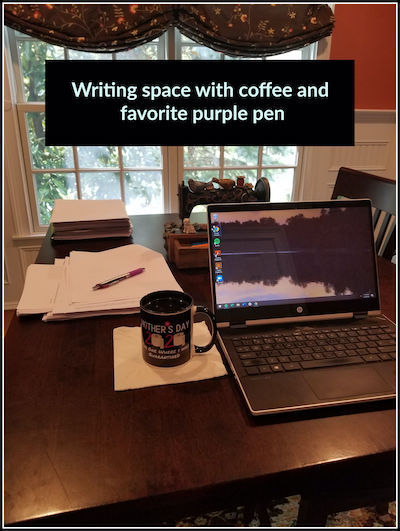
I hope these organizational tips help! As a NaNoWriMo Coach, I’ll be taking over the NaNoWriMo Twitter account through Friday, October 23. Reach out and share your questions or your own organizational ideas. Happy Writing!
Yvonne Ventresca is an award-winning author dedicated to writing suspenseful stories that readers can’t put down. Her Crystal-Kite-winning YA debut, Pandemic, continues to be a timely read about surviving a widespread deadly virus. Her second novel, Black Flowers, White Lies explores toxic relationships and won a Gold “IPPY” for best YA fiction. You can learn more at YvonneVentresca.com, where she often features resources for writers.
To connect with Yvonne: Website | Instagram | Facebook | Twitter
October 19, 2020
How to Reduce Your NaNo Prep Stress

Every year, we’re lucky to have great sponsors for our nonprofit events. Campfire, a 2020 NaNo sponsor, is a writing software with tools to help you design your story. Today, Campfire content creator Levi Johnson is here to share some tips on reducing your pre-noveling stress. Be sure to read to the end to find out how you can win up to $3,000 to self-publish your NaNoWriMo novel!
Write 50,000 words in a month?! You kidding me?! The prospect is enough to make even veteran writers feel excited and maybe even a little nervous. No worries! NaNoWriMo 2020 is a huge undertaking, but it’s also a ton of fun. Although if you’re trying to fight off any pre-Nano anxiety, a great way to lower nerves is by planning ahead, and a great tool for that is Campfire Blaze.
Writing 50k words in a single month is going to take a ton of time, so we want to save you as many minutes as possible. If you’re a plotter, Campfire Blaze’s timelines will give you a flexible and visual place to build your story, so you always know what’s going to happen next as you move through November.
There are a handful of pre-made plot structures out there. From the Hero’s Journey to Three Act structure, they are all good options for deciding your story’s shape, but characters are the most important thing when planning for NaNo. Creating characters with their own wants and needs using Campfire Blaze’s character sheets will keep the words flowing even when writer’s block hits.
Your story may change as you write throughout NaNo, so don’t worry if you start to veer off from the path you built. It’s okay to take a page from the panster’s book and trust the characters. They’re the guiding light that will bring you to 50k words in 30 days.
Now, pansters may say “I don’t need planning software!” but that’s not the only thing Campfire Blaze is useful for. Campfire Blaze can also help record those important details and plot points for quick reference as your word count grows:
Need to remember a character and what they look like? Check their character sheet.What was the name of the bar they went to in Chapter 2? Check the locations tab.What chapter did your main character get dumped? Check your timeline.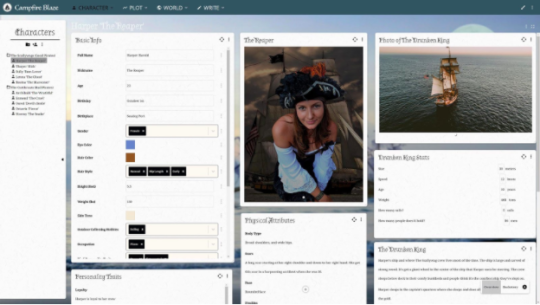
Having all of your information organized in one place can save you time flipping through pages to find that one crucial detail you can’t quite remember. Just take a few minutes at the end of each writing session to record the important details.
If you’re weighing the price of Campfire Blaze against its usefulness, you don’t have to! Each of Campfire Blaze’s modules has a free version. The only limitation is the number of articles you can make in each module. That means if you don’t plan on creating an epic during November, then Blaze might be completely free for you!
Regardless of if you’re a pantser or plotter, Campfire Blaze can help you save time while writing, break through writer’s block, and spot plot holes before your readers do.
Also! Campfire Technology has a special contest for NaNoWriMo winners this year. Submit your story and your Campfire Blaze file to be entered to win $3,000 for editing and publishing services for your novel. Make sure you try out Campfire Blaze for NaNoWriMo 2020! Good luck!

Levi Johnson is a writer and content creator from Knoxville, Tennessee. You can follow his writing journey on Campfire Technology’s YouTube channel.
October 16, 2020
30 Covers, 30 Days Is Here!

Greetings, Wrimos!
It’s finally here! How exciting is it that NaNoWriMo is (almost) upon us once more, and with it, that annual festival of design and delight! That yearly event of visuals and very exciting stuff!
Yes, I’m talking about 30 Covers, 30 Days!
For those of you not in the know (and if you are not in the know, you are valid and welcome), 30 Covers 30 Days is an event in which 30 Wrimos (23 NaNoWriMo participants, and 7 Young Writers) are selected to receive stunning, ingenious covers from a group of talented and generous graphic designers.
It’s wild fun, it ropes graphic designers into our month of frenzied creativity, and it’s a fantastic showcase for both the writers and the designers!
Our good friend Debbie Millman helps us coordinate it every year, so let’s give her a big round of electronic (and socially distant) applause.
So what do you do if you want one of these fancy, brand-new, and completely original covers?
Just fill out this year’s nomination form. You can nominate somebody else’s novel, or your own. It should be noted:
Make sure you read over your form carefully, because there’s no way to update the info. If you need to correct something, please submit a Withdrawal Form, and then re-submit your novel.Your real/legal name is not required. If you have a preferred name, pen name, or any other kind of name you would like to use, that’s OK by us!
The submission form will remain open until November 15th. If you don’t quite know what your novel is about yet, don’t worry! Take a week or two to figure it out, and then submit! There’s no priority based on submission date.
If your novel is selected, we’ll get in touch with you for final confirmation!
Visit the NaNo Artisans Forum for Wrimo-designed covers! If you want to make a cover, or if you just can’t imagine enduring the suspense of 30C30D, it’s a great place to connect with other people. Be nice to each other out there!
After you nominate a novel, there’s nothing much to do but wait (and perhaps hum the Jeopardy theme song to yourself). Or I guess you could start prepping your novel, but where’s the fun in that?
So what are you waiting for, Wrimos?
NOMINATE YOUR NOVEL FOR 30 COVERS, 30 DAYS!Let’s do this!
—Chyina, Editorial Intern
October 15, 2020
3 Tips to Help You Finish Writing Your Novel (For Real This Time)

Every year, we’re lucky to have great sponsors for our nonprofit events. Hermit, a 2020 NaNo sponsor, is a fast, elegant, and free to use web-based writing application. Today, Alex, its founder and developer, shares three tips to (actually) help you finish your novel:
In this post, I won’t be telling you that you should use Hermit—you can try it out and decide that for yourself. I want to help you finish your project by sharing tips I regularly use when writing software.
Tip #1: Quit while you’re ahead.The problem with creative projects is that they require a good dose of motivation and inspiration—2 things you can’t buy at a local store. A tip that worked well for me in the past is to quit and take a break whenever I’m thrilled at the amount I got done and feel like I could keep going. I know this might sound counter-intuitive, but the idea here is to make sure you pause your effort while having a positive mindset. If you stop when you’re stuck, the next time you pick it up, that’s all you’ll remember, and it’ll be extra challenging to get motivated. Remember, long projects like writing a novel or software are marathons and not sprints—you have to trick yourself into staying motivated.
Tip #2: Keep a list of to-dos and ideas.Whenever I work towards a significant milestone, I take a piece of paper or post-it and write down the next four or five things I need to do and a list of potential ideas to investigate. The goal here is to have a list of simple things you can jump in and do whenever you have a bit of spare time. I then add more to-dos and ideas as I chip away at that list. If I accidentally do something that wasn’t on the list, I add it to the list and scratch it off right away—it keeps me motivated. I tell you, nothing makes you feel invincible as a growing list of scratched off items. Make sure there’s always a couple of simple things on that list, and you’ll fly by the finish line in no time.
Tip #3: Keep it a secret.I’m sure this one will be quite controversial. Talking about your work in progress project to others around you should keep you accountable and motivated, right? Well, it never worked out well for me. Every time I would start talking about a project to a friend, those two things would happen:
I would get a feeling of satisfaction and achievement. Usually, this would be good, but here I would be getting the same feeling I would get from actually completing my project. Nothing hampers motivation like that.I would create unnecessary pressure on myself to produce something perfect. The more publicly I would talk about my project, the more likely I would take forever to polish it. Keep your project to yourself, and all of a sudden, you have no expectations to live up to—it’s a fantastic feeling.I hope those tips come in handy next month as you embark on this exciting journey. If you’re still looking for the best writing app, I invite you to give Hermit a spin. It’s free, and the premium features also are for a full year if you subscribe before the end of November.
Alex is the founder and developer of Hermit, a free to use, secure, and lightning-fast writing application for everybody who likes to write, from scribblers to aspiring authors. He’s been continuously improving it over the last 7 years and plans to continue doing so. His next goal with Hermit is to tailor the experience for different writing projects and let authors order physical copies of their work with as little effort as possible. Sign up & subscribe now to get all premium features for free for a whole year.
Top photo by Kat Stokes on Unsplash.
October 14, 2020
A Character-Creating Exercise That Will Make Your Story Stand Out

One of the most important parts of any narrative are the characters and how they relate to each other. But sometimes, when it comes to writing characters different from ourselves we end up stumped. Here’s an exercise created by YWP Participant Natalie Gertsenberger to help you out!
As writers, we all know what makes each of our stories unique. We know what makes them stand out. What makes them different. But in general with any novel, the characters are the center of our story. The heart of it all. Characters are who we relate to, they are the people that take us into their world, and bring us along for the ride. Let’s face it—the reason we read is because we want to experience the impossible. And we can’t do that without our beloved characters.
Characters are like our friends. If you’ve ever noticed, our friends are more often than not, the polar opposites of ourselves. But you know what? It works. And that is the key to creating diverse, multi-dimensional characters.
When you create your characters, strive to create personalities that your readers will remember long after they’ve finished your book. When creating your characters (and this applies to your protagonist, antagonist, side characters, and supporting characters) it is best to create characters that are not like yourself.
Characters that are not like ourselves are often the most interesting—not only to read about, but also to write. When we read we become attached to our characters both because of their personality and because of the conflict they face. A character’s conflict can have to do with many different things, but often arises from something that sets them apart from the norm of their world. This is what gets us intrigued.
So when you’re creating some new characters, try making them as different from yourself as possible, and you may find that it works out better than you would have thought.
Character-Creating Exercise:Make a list of five of your favorite characters from some books you’ve read and loved.Pick three things from each of those characters that makes them stand out, causes them to face lots of conflict, or makes them different from yourself. Write these things down. (They could be anything: a disability, a personality trait, clothing choice, special powers, etc.)Choose some of the characteristics that you pulled from different characters and put them together. Now write a character profile for a new character using these traits, and give them a name.Congratulations! You now have a new character! As you continue to build your character, ask yourself these questions:
How are this character’s experiences different than mine? What research can I do to make sure I’m portraying these experiences as authentically and respectfully as possible?Are there any experiences that this character and I have shared? Why does this character stand out in the world they live in? What challenges does this character face, either from external or internal conflicts?By answering these questions, you may find that you can begin to work in other important character factors such as conflict and backstory, which will hopefully lead to an amazing plot and more diverse characters!
Keep these questions in mind when you are sitting down to write. The goal is to give both yourself and your readers a glimpse into another life, to make these characters as real and well-rounded as possible. We want to fight with these characters and help them achieve their goals!
Try to write like a reader. Think about what attaches you to characters, and write in a way that will get others attached to your characters.
Now, what are you waiting for…? GO WRITE!

Natalie is a serious writer who loves to experiment with many different ideas, and feels a strong connection to her characters. She loves to read, write, and doodle. She may or may not know how to unicycle and plans on being an editor when she gets older. She loves the feel of fall and you can usually find her wrapped up in a fuzzy blanket by the fireplace in her home in the East North Central part of the Midwestern United States.
Top photo by Frank Vessia on Unsplash.
October 13, 2020
Great Advice from the Great Writers of The Great Courses

Every year, we’re lucky to have great sponsors for our nonprofit events. Today, The Great Courses Plus—a video-on-demand service for lifelong learning—shares some advice from great writers they’ve partnered with. The Great Courses Plus is a NaNoWriMo 2020 sponsor.
The past few months have probably shown you a different world than the one you’re used to: outside your door, there’s less commuter traffic, fewer crowds waiting to be seated at the local eatery or queueing up for the opening of the latest movie, no kids chasing each other with sticks and screaming as they wait for school buses.
Inside your door, however, it’s a whole new world. That’s because your job, your school, your favorite restaurant, your movie theater… all of your outside worlds are now contained within the four walls you call home. And all that chaos is stuck inside with you. (We know. We live there, too.)
Even if you don’t have children, pets, or additional adults going stir crazy around you, 2020 has provided enough chaos on a daily basis that it’s almost impossible to focus on a five-word tweet, let alone commit to a 50,000-word novel. The positive side is that these distractions could turn into some pretty fantastic book fodder. But of course, sitting down and writing about this hectic time while still in the midst of it? Well, that’s a completely different story.
To help out, we turned to some of our favorite writing professors to see what they are doing to get themselves through these trying times:
Jennifer Cognard-Black
Becoming a Great Essayist;
Great American Short Stories: A Guide for Readers and Writers
James Scott BellRemember when your biggest frustration was carving out some time to write? And yet now, when so many of our usual commitments and pleasures have been stripped away, the one thing many of us have is time. But how to harness this extra time—that is the question. It’s just so seductive to try out yet another sourdough bread recipe or to binge yet another show on Netflix. My advice? Engage in slowthink. Don’t ask yourself, “Why am I not writing?” Instead, ask yourself, “What might I want to learn, to know, or to create?” During the Great Pause, I’ve been reading all of the millennial novels and memoirs about women and food that I can get my hands on, and I’m slowthinking my way through them. There’s something there—I’m not sure what—that I want to write about myself, but since I don’t yet know what that is, I’m just underlining striking phrases and making the occasional note in my writing journal. And that’s okay; I’m relaxing my creative mind to see what bubbles up.
How to Write Best-Selling Fiction
James HynesWrite tight. Don’t think about the entire project, or how the world will receive your book once it’s finished. Concentrate on the scene in front of you, beat by beat, emotion by emotion. Get lost in the action. Then your writing will become a respite as well as a passion. As Ray Bradbury once said, “You must stay drunk on writing so reality cannot destroy you.”
Writing Great Fiction: Storytelling Tips and Techniques
Angus FletcherDuring the pandemic, writing fiction has become my chief solace from the stress of quarantine (and everything else). I’ve found that active engagement with my current project—the creation of characters and scenes, or just tinkering with the prose—has calmed me much more than bingeing another series on HBO or eating too much (though I do those, too). And it’s not just an escape: It’s the place where I can take whatever I’m feeling at the moment and turn it into narrative.
Screenwriting 101: Mastering the Art of Story
I have a little insight into this because my next book is about how literature of all kinds—novels, poems, films—can help improve our mental health and well-being.
And a tip that comes from literature, and that’s backed by neuroscience, is gratitude. Gratitude shifts our focus away from ourselves, and it also shifts our negative emotions, which interfere with writerly flow, into positive emotions, which boost it. Gratitude isn’t always easy to conjure in times like these, of course. But one useful method for accessing it is what psychologists’ term “reframing.”
So, for example, when your lovely children are interrupting you, causing you to lose your train of thought, and possibly your mind, take a moment to think: How wonderful it is that I’m a parent. How lucky I am to have these kids. Recall a specific moment—as precisely as you can—when your kids popped your life with joy or wonder. And in that instant, your stress will drop, your calm will increase, you’ll be more effective at figuring out an effective way to give the kids a way to amuse themselves, and you’ll be more ready to write when you return to your keyboard.
Or, when you’re suffering from writer’s block, think: How lucky it is that I don’t need to write this novel, because I have so many wonderful novels already on my bookshelf. Then, go read one of those novels, immersing yourself in its flow. And as you get deep into that flow, you’ll often feel your block dissolve, allowing you to return to your own writing with a fresh energy and perspective.
Not every negative emotion can be converted like this, of course. When we suffer grief, it can’t be reframed away. Our brains need time to process sorrow and heal. But a great many self-doubts and daily frictions can be softened with gratitude. And no matter what happens to you in your life, you can always feel grateful for being a writer. For whatever the happening is, no matter how hard or painful it may be, you have been gifted a pen to take that happening and make some good of it.
Advice from professional writers who are facing the same distractions and roadblocks you are can be helpful. And to make things better, The Great Courses Plus provides you with a wealth of resources to help you get through these weird times. Clear your mind with meditation, focus your thoughts with mindfulness, jumpstart your creativity with a “brain hack,” research the worlds and periods you’re writing about, learn to create a single great sentence—whatever you need, we have a course that will help.
Stay well and keep writing.
Top photo by Element5 Digital on Unsplash.
Chris Baty's Blog
- Chris Baty's profile
- 63 followers



